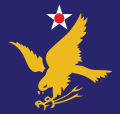Initial organization and training
The squadron was first established in March 1942 at Gowen Field, Idaho as the 34th Reconnaissance Squadron, one of the original four squadrons of the 306th Bombardment Group. [3] [4] In April, its personnel moved to Wendover Field, Utah, where it began training with Boeing B-17 Flying Fortress heavy bombers and was redesignated as the 423d Bombardment Squadron. [1] On 1 August 1942, the squadron's ground echelon began its deployment, spending a week at Richmond Army Air Base, Virginia before moving to Fort Dix, New Jersey at the Port of Embarkation. It sailed on the RMS Queen Elizabeth on 30 August, arriving in Scotland on 5 September 1942. The air echelon departed for Westover Field, Massachusetts, and began ferrying their B-17s to England via the North Atlantic ferrying route. [4] [5]
Combat in Europe
The squadron settled into its combat station, RAF Thurleigh, England, in early September. Although several bomber units arrived in England before the 423d, when these units left England to participate in Operation Torch it became, along with its companion squadrons of the 306th Group, the oldest bombardment squadrons of VIII Bomber Command. It flew its first combat mission on 9 October 1942 against a steel factory near Lille, France, but with poor results. This was the first mission on which VIII Bomber Command assembled a strike force of over 100 bombers. [5] [6] [b] The squadron operated primarily against strategic targets, including the locomotive factory at Lille, marshalling yards at Rouen, France, and Stuttgart, Germany. The squadron took part in the first strike into Germany by bombers of Eighth Air Force on 27 January 1943 when it struck U-boat yards at Wilhelmshaven. It struck shipbuilding yards at Vegesack, ball bearing plants at Schweinfurt, the aircraft factory at Leipzig, Germany, and similar facilities. [4]
On 1 May 1943 the aircraft in which Staff Sergeant Maynard Smith was a gunner was struck by enemy fire, igniting fires in the plane's radio compartment and waist. Sgt Smith threw exploding ammunition overboard, extinguished the fire, administered first aid to the wounded tail gunner and manned his gun until enemy fighter aircraft were driven off. Sgt Smith was awarded the Medal of Honor for his actions on this mission. [4]
On 11 January 1944, the squadron participated in an attack on an aircraft plant in central Germany, near Brunswick. Extensive cloud cover had resulted in the recall of two of the three bombardment divisions involved in the mission and made the rendezvous of the fighter groups scheduled to provide cover in the target area difficult. In contrast, clear weather to the east of the target permitted the Germans to assemble one of the largest fighter formations since October 1943, with 207 enemy fighters making contact with the strike force. [7] For this mission, the squadron was awarded the Distinguished Unit Citation (DUC). The following month the squadron earned a second DUC for its performance during Big Week, an intensive bombing campaign against the German aircraft industry. Despite adverse weather on 22 February that led supporting elements to abandon the mission the squadron and group effectively bombed the aircraft assembly plant at Bernburg, Germany. [4]
The squadron also performed in a tactical role, assisting ground forces Operation Cobra, the St Lo breakthrough, Operation Market Garden, the attempt to establish a bridgehead across the Rhine near Arnhem in the Netherlands, stopping German attacking forces in the Battle of the Bulge, and bombing enemy positions during Operation Varsity, the airborne assault across the Rhine in the spring of 1945. [4]
After V-E Day, the squadron became part of the occupation forces and participated in Project Casey Jones, the photographic mapping of portions of Europe and North Africa. [4] When the 306th Group began to phase out of the project in July the squadron was attached to the 305th Bombardment Group. Toward the end of 1946 responsibility for the unfinished portion of the project was transferred to XII Tactical Air Command. [8] In February 1946, the squadron moved to Istres-Le Tubé Air Base, France, where it absorbed elements of the inactivating 92d and 384th Bombardment Groups, returning to Germany in July. [5] The squadron was inactivated in December 1946. [1]





